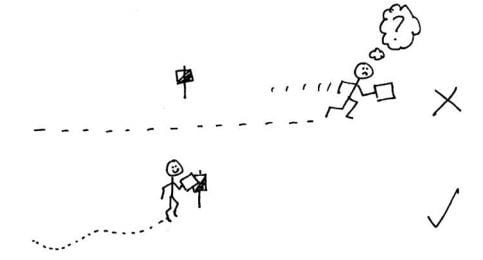Good map 'contact'
Stay in contact! Once contact is lost, relocating takes a long time. Keeping in contact may mean slowing down, to look at the map and surroundings more often, but at least it does not lose as much time as getting lost does.
I have been writing these tips for the last 2½ years. But I still make mistakes myself. I rarely count paces, I do not select safe routes, I rarely have a fine-O/ coarse-O strategy and I simply don't concentrate enough.
All of these have been the subjects of previous tips. I know what I should do but I don't always do it! So what is the real challenge? Obviously the overall challenge is to complete the course in the shortest time possible. So does that mean running as fast as possible? I suggest probably not.
Orienteering is so much more than running. A faster runner might cover the ground a few seconds quicker, but a poor navigator can lose several minutes or more on a single error. Taking that into account, thinking about getting there in the shortest possible time is not very helpful, as it tends to encourage reliance on speed. Most of my errors involve charging ahead and then not knowing exactly where I am on the map any more. This is known as losing contact with the map.
Once contact is lost, relocating takes a long time. Keeping in contact may mean slowing down, to look at the map and surroundings more often, but at least it does not lose as much time as getting lost does.
So I'm going to change focus. From now on I'm not going to think about getting to the next control in the shortest possible time. My challenge is to avoid mistakes and to keep in contact with the map at all times. A clean error- free run that does not rely on luck is my new objective. Once I can achieve that I will try to speed up again.
Richard Sansbury
Originally published as Stay In Contact, training tip #29 from QuOnicle no 165, April 2016
